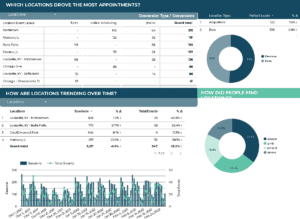With the decision to expand to new locations—either through merger and acquisition (M&A) or de novo—you’re sure to encounter some new search engine optimization (SEO) challenges. These may include:
- Mitigating underlying technical website issues
- Ramping up review generation
- Minding the most valuable performance metrics
- Auditing and integrating acquired websites
- Building a backlink portfolio
- Localizing content with purpose
Far too many organizations fail to plan for these challenges, only to find growth is stalling during the post-acquisition phase. This article explores common SEO challenges that high-growth groups face as they expand to new markets or go through M&A. I’ll also provide solutions from my own team’s experience working with multi-location groups.
Most Common Issues Healthcare Organizations Face
1. Thinking in the Moment Instead of Planning for the Future
2. Neglecting Website Scalability
3. Failing to Address Site Maintenance and Underlying Issues
4. Not Investing in Review Generation
5. Focusing on the Wrong Right KPIs
6. Not Merging Google Business Profile Listings
7. Skipping the Site Audit for Acquired Sites
8. Incorrectly Redirecting Acquired Sites
9. Overlooking M&A Link Building Strategies
10. Ignoring Localized Content
11. Fixating on Localized Content
1. Thinking in the Moment Instead of Planning for the Future
In younger organizations, business leaders focus too much on expanding services and providers while ignoring issues that may come up down the road. If your website looks great with the five locations you just acquired but will eventually look cluttered when you reach 50 locations, it may be worth investing in updates now.
From an SEO perspective, this can be how you handle your business schema markup on location pages. If you’re still writing local business schema by hand for each location you acquire, it may be worth investing in a more dynamic solution to help improve acquisition efficiency.
I see the same now vs. the future problem with respect to websites. If you’re still custom-building every single location page for each new location, it may be worth investing in an API solution, or a more scalable website, to help improve website maintenance operations down the road.
How to be more future-oriented
Ask for help! Lean on your consultants that have been there before. This could be your digital marketing agency, business consultant, professional mentors, etc. Ask them what common hurdles you should prepare for. Ask them what they wish they knew when they were younger. Most importantly, start answering the hard questions today, before you add fifty more locations.
2. Neglecting Website Scalability
I have come across a lot of websites that look and function wonderfully—on the front end. On the back end, it’s a twisted mess that requires a lot of hands-on upkeep. I asked John McAlpin, our Director of SEO Strategy, for some other common signs of poor website scalability. He focused on three:
- The need to rebuild sections of the site that could be dynamically populated
- A static sitemap that doesn’t update with new content
- Flat site architecture
How to improve website scalability
The best way is to first work with your SEO or web team to bucket out your content into organized sections. Think, filing papers into grouped folders. This should constitute the framework of your site’s information architecture. From there, make a list of web elements that are frequently rebuilt on every new page, and that could be dynamic (for example, a section for recent blog posts). Finally, work with your SEO or web team to prioritize an action plan to scale your website.
3. Failing to Address Site Maintenance and Underlying Issues
When I start to hear words like “clunky,” “janky,” or “buggy” with regard to a website, I know a mess is waiting for me when I open the hood. These could be due to a lack of resources or technical know-how, or willful neglect. Either way, a lack of site maintenance indicates a future roadblock for multi-location scalability.
Common site issues:
- Multiple technical SEO issues
- Out-of-date WordPress version
- Out-of-date plugins
- Too many unused plugins
- Broken features/functions
How to address underlying site issues
You’ll need to conduct a full SEO technical audit. Audit the entire backend of the website, too. As my colleague John McAlpin recommends, check Google Search Console for coverage/penalty issues. All of these audits will give you a clear picture of where your site is today and where it needs to be. They also provide a framework for a more scalable approach to site maintenance.
4. Not Investing in Review Generation
This is a common culprit. Many healthcare organizations fail to even establish digital business listings on platforms like Google Business Profile, Healthgrades, ZocDoc, let alone maintain them. When it comes to expansion, reviews often become the last priority.
The problem is reviews are often the first thought for patients searching online. Reviews give healthcare consumers confidence that a provider is trustworthy and worth their time. Businesses with unfindable business listings or too few reviews will risk losing viable leads that are ready to book an appointment.
How to scale review generation
There are plenty of review management tools available to support this effort, like Birdeye and Podium. You can also hire a partner to scale your review generation program. Either way, invest in your digital reputation because it’s directly tied to patient growth.
5. Focusing on the Wrong KPIs
In terms of performance metrics, the right mix is going to vary from business to business. Rather than attempt a definitive list, I’ll share some of the common mistakes I see:
- Focusing on only one or two metrics while ignoring the full story
- Focusing on too small or too large of a target keyword set
- Focusing too much on industry terms, not the language the patients use
- Ineffective or superficial reporting (that doesn’t reflect the full patient journey)
How to identify the right KPIs for performance tracking
We recommend collaborating more closely with business partners (in-house or agency) to help tell the story with data. Ask stakeholders what’s most important to them. Tie metrics to key points along the customer journey. You can also take advantage of free data visualization tools like Google Data Studio to find new ways to report and share data.

6. Not Merging Google Business Profile Listings
Your Google Business Profile (GBP) listings can work for you or, in some cases, against you. We see far too many organizations spin up new listings for acquisitions while leaving the old listings out in the wild. This sends the wrong signals to Google while creating a poor user experience for potential customers.
How to properly manage GBP listings
Once you acquire the original business listing, work with GBP support to merge the listings. This is important because then you will acquire their existing reviews. Of course, another option is just to acquire the listing and change the name and URL.
7. Skipping the Site Audit for Acquired Sites
Don’t make the mistake of redirecting acquired sites without looking at content performance. This can create all kinds of issues that degrade SEO health, from excessive redirects to duplicate “thin” content.
How to bring acquired sites up to best practices
Again, you’ll want to conduct thorough content audits to see if there’s content worth keeping. We recommend using tools like:
- SEMrush (keyword performance)
- Google Search Console
- Google Analytics
8. Incorrectly Redirecting Acquired Sites
Speaking of redirects, there’s a right and a wrong way to go about it. And it’s not always clear-cut, especially when bringing new sites into the fold. Here are three aspects of redirects to consider:
Wildcard vs. 1:1 Redirects: A wildcard redirects an entire website to one page. A 1:1 redirect sends individual pages to the most prominent page on the new site (the homepage, for example). We find that 1:1 redirects are the preferred option, though wildcards are acceptable when there are website/host limitations (for example, Squarespace, Wix, and other website builders).
Triggering site migrations in Google Search Console: GSC has a feature that allows you to notify Google of a website migration. Most companies don’t know about this. You’ll avoid a lot of issues if you work with your SEO team to conduct site migrations using GSC.
Proper tracking for acquired sites: When a site is redirected, Google Analytics tracks this as direct traffic, which is pretty useless. As a standard practice, our SEO Director John McAlpin sets up redirects with UTM parameters to help track performance in Google Analytics. He typically follows the formula below to keep things clean and consistent:
| https://www.site-getting-redirected.com/?utm_source=localhomecareagency.com&utm_medium=Referral&utm_campaign=Redirect |
|---|
9. Overlooking M&A Link Building Strategies
We come across a lot of different perspectives on link building. Regardless of your stance, a solid backlink portfolio is still a critical part of a site’s ability to rank in search. In my own work, I find that 80-90% of multi-local healthcare organizations think simple press releases are good enough for link building. This is hardly enough.
How to build a linkbuilding strategy for M&A
By all means, yes: launch press releases when you open or acquire new businesses. But you need to do more. We also like to conduct unlinked and linked brand mentions to help earn links from the original site to the new site. These two strategies are low-hanging fruit, relatively speaking.
For more, read: Easy Link Building Strategies to Grow Your Business’ Authority and Increase Rankings.
10. Ignoring Localized Content
When starting a new site, focusing on local terms is the easy part. However, when you expand to dozens, hundreds, or even thousands of locations, things get more complicated. At scale, many teams make the mistake of only focusing on higher-volume, “short-tail” keywords (e.g., allergy testing, allergist, etc.) that are very competitive.
How to localize your content for growth
You’ll need a more localized keyword strategy. Typically, this includes longer-tail keywords that include a location modifier (e.g., “allergy testing in downtown Atlanta” or “top-rated allergist in Spokane). Once you have a more targeted keyword list, create more localized content on each business’ location pages. Find opportunities on these pages to add local keywords where they make sense. Don’t be spammy! Natural opportunities include:
- Headers
- “About this location” section
- Directions to location
- Titles and meta description
- Testimonials
You can also write blog posts about any events or activities that specific locations may be participating in for their area.
11. Fixating on Localized Content
Of course, the sword cuts both ways. Some multi-location businesses give too much weight to localized content. The common signs are:
- Local keyword stuffing
- Creating variations of service pages for each location (thereby creating microsites)
- Putting each location on a subdomain with their own microsite (subdomain microsite)
- Publishing blog posts that are too local-focused
- Creating too many doorway pages (service pages for each city, state, and metro area)
How to balance out localized content
If you find that you’re working on a site suffering from this problem, work with your SEO team to conduct a content pruning audit. We call this a “remove and redirect” strategy. During this audit, your goal should be to maintain a clean and organized site architecture.
Remember What Scalable SEO Is Really About
There’s a reason that scalable, multi-location SEO strategies are far more nuanced and complex: healthcare consumers seek out care in a variety of different ways. The more digital patient journeys you need to account for, the more touchpoints your SEO strategy needs to reach. It’s no wonder that inadequate SEO strategies so often contribute to slow growth for multi-location healthcare providers.
What we’ve laid out above are the common mistakes that healthcare organizations make. The solutions for each consideration come straight from our own experience scaling SEO in this space. And I can promise you that even the most scalable SEO strategy is going to stumble if it fails to put the patient in the driver’s seat.

